Celebrating Women Horticultural Heroes
March 1–30
Join us during Women’s History Month and view a special selection from our Horticultural Heroes exhibit. Learn about women who have helped shape our understanding of plants, pushed the boundaries of societal norms, and paved the way for women in the world of horticulture.
The Garden’s Horticultural Heroes exhibit, is a one-of-a-kind traveling exhibit that features twenty portraits by talented local artists of diverse leaders of horticulture who championed their causes throughout history.
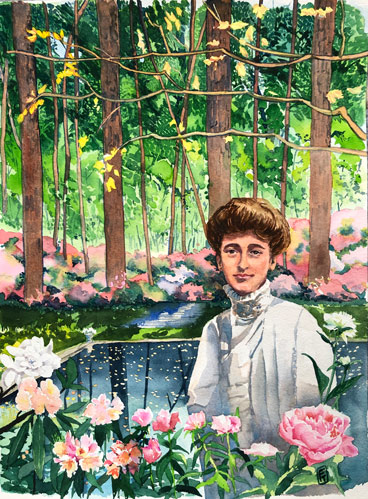
Marian Coffin (1876–1957)
Hailed as the first woman landscape architect, Marian Coffin designed gardens for some of the wealthiest and most famous families in the country, including the Huttons, Fricks, Vanderbilts, and most notably, the du Ponts.
After graduating from MIT as one of only four women in the student body, Coffin immediately faced adversity. No firms would hire her because she was a woman, so she decided to strike out on her own and set up an office at the National Arts Club in New York City. Coffin firmly believed that any homeowner could transfer any lot into a garden through good design. Her first commission was for a suburban garden in Queens in 1906, right around the time she was accepted as a Junior Member of the American Society of Landscape Architects (ASLA).
Coffin’s designs quickly grew in popularity and so too did her business. She hired a team, which allowed her to take on new, larger commissions. She also started an apprenticeship program for aspiring women landscape architects. Coffin always insisted upon equal pay.
Becoming a Fellow of the ASLA in 1918 widened Coffin’s influence and she was soon the most sought-after East Coast landscape architect. Her life-long friendship with Henry Francis du Pont helped grow her career as well. Through her connection with du Pont, Coffin served as the University of Delaware’s landscape architect from 1918-1952. In her role, she focused on incorporating diverse flora to give the campus displays of foliage year-round. Female students helped to fulfill the vision by planting trees.
Coffin’s most lasting legacy can be found in the gardens she designed at Winterthur for Henry Francis and Ruth du Pont starting in 1929. Her style and influence are evident in the long sight lines, defined entryways and paths, focal points of statuary and pools of water, semi-circles surrounding rectangular spaces, and enclosures of stone and shrubbery. In Coffin’s lifetime she earned over 130 commissions and was a pioneer for women in the field of landscape architecture.
About the Artist, Fleur Thesmar
After a successful career in France in lobbying and telecommunications, artist Fleur Thesmar moved to the U.S. where she decided to follow her heart and started painting again. At first, she wanted to depict beautiful American Landscapes. Her second interest is portraiture because of the feelings and transparency this art form allows. As an emerging artist she wants to bring people the enchantment of contemplation.
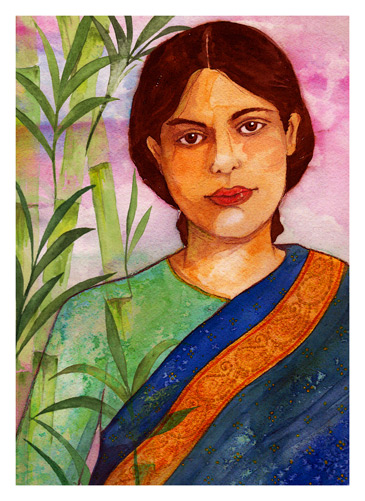
Dr. E.K. Janaki Ammal (1897–1984)
Botanist, author, and activist are just some of the few professions E.K. Janaki Ammal attained in her lifetime. Balking tradition, Ammal pursued an education when less than 1% of women in India were literate. She crisscrossed the globe many times to further plant science and is known for her work to protect India’s rich tropical diversity.
The first Indian woman to earn a Ph.D. at an American university, Ammal’s research at the University of Michigan focused on breeding interspecific plant hybrids, and it caught the attention of the Imperial Sugar Cane Institute. She successfully produced a sugar cane crop better suited for India’s tropical environmental. Despite her work often being overlooked because she was a woman, her career came to international attention while working at the John Innes Centre in the UK. She coauthored Chromosome Atlas of Cultivated Plants with Cyril Dean Darlington (noted geneticist and eugenicist) which recorded the chromosome number of about 100,000 plants. Ammal’s time in the UK also saw her working at the Royal Horticultural Society where she developed a new variety of magnolia, Magnolia kobus ‘Janaki Ammal.’
Enticed by an offer from the Indian government to reorganize the Botanical Survey of India, Ammal returned to her native country and was appointed the director of the Central Botanical Laboratory. In this role, Ammal faced sexism and saw the impacts of how British colonialism encouraged native plants to be removed from India for study in the UK. She also discovered that in an effort to feed the nation, severe deforestation had occurred throughout the country. An area known as the Silent Valley in Ammal’s home state of Kerala was next on the list to be cleared for agriculture. This motivated Ammal to turn her attention to activism. She began a chromosomal survey of the Silent Valley plants so botanical knowledge would not be lost. Her work became part of a larger people’s movement to preserve the valley and the forest. Thanks to the dedication of those involved in this movement, the plans for deforestation were abandoned. The area is now the Silent Valley National Park, one of the last undisturbed swaths of forest in India.
About the Artist, Lisa Graves
Author and illustrator Lisa Graves combines her passion for art and history with the History Witch project, a weekly series dedicated to fascinating stories and portraits of both well-known and forgotten women. She has 17 published books for both children and adults and currently lives in North Attleboro, MA with her two highly creative children and her dog, Henry.

Theodosia Burr Shepherd (1845–1906)
The “Flower Wizard of California,” Theodosia Burr Shepherd is believed to be the first woman in the United States to hybridize flowers. Her journey in horticulture began in the 1870s when she moved to Ventura, California for her health. Shepherd’s love of gardening blossomed here, and she established the Theodosia B. Shepherd Company in 1884. By 1892, she was sending seeds and bulbs to customers in the eastern U.S. and Europe, and in 1902, the company was incorporated. Shepherd became known as the “Pioneer Seed Grower” and her company is credited as the foundation of California’s seed industry. She developed new varieties of begonias, nasturtiums, petunias, poppies, roses, and more. Perhaps her most well-known are the ‘Golden West’ California poppy, the ‘Oriole’ rose, ‘Heavenly Blue’ morning glory, and the ‘California Giant’ petunia.
Shepherd wrote and lectured on her work and was a women’s rights activist. She was an advocate of dress reform, as long skirts were not well suited for gardening. Among her friends were Susan B. Anthony and Julia Ward Howe, and both visited her garden in Ventura. Shepherd believed that the practice of gardening and a connection to nature empowered women.
Upon Shepherd’s death, her daughter, Myrtle Shepherd Francis, carried on her legacy by developing double petunias. A biography of Shepherd, written by Francis in the 1940s, was published in 2014.
About the Artist, Caitlin Mitchell
Caitlin has a bachelor’s degree in fine arts with a minor in Art History, and when she’s not doing something creative, she’s skydiving or zip lining! Along with drawing and painting, going on road trips with her pals and taking shots with her 35mm camera are some of her favorite things to do.
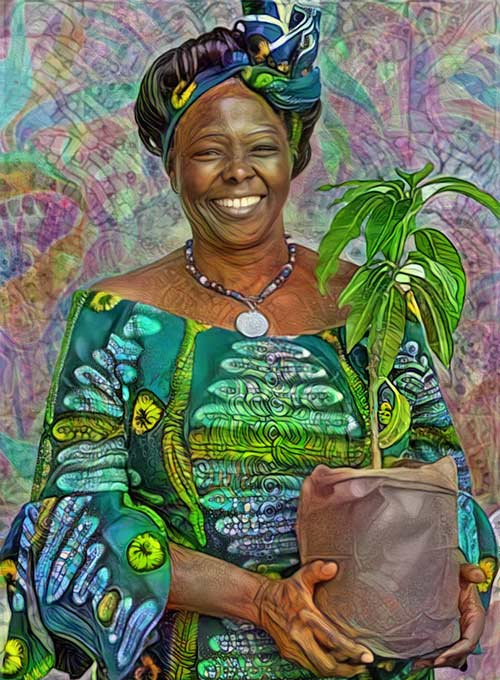
Wangari Muta Maathai
Born in Kenya on a small farm, Wangari Muta Maathai dedicated her life to opposing unjust practices. She was the first African woman and first environmentalist to win a Nobel Peace Prize for her contribution to sustainable development, democracy, and peace. Founder of the Green Belt Movement in 1977, Maathai mobilized communities to take responsibility for their actions and collaborate with each other to be better agents of change. Since its founding, the Green Belt Movement has inspired similar initiatives to be adopted in six other African nations and planted over 51 million trees across that continent. It is estimated that a UN campaign founded on the same principles led to more than 10 billion trees being planted worldwide.
Not only did Maathai’s work led to the planting of trees, but also to the empowerment of women. It is estimated that more than 900,000 Kenyan women benefited from the tree-planting campaign by selling seedlings for reforestation. More than 30,000 Kenyan women were trained in forestry, food processing, bee-keeping, and other trades that help to preserve the land and its resources.
Maathai was also a political activist who worked to bring democracy to Kenya. As an elected member of Kenya’s Parliament, she served as Assistant Minister for Environment and Natural Resources between January 2003 and November 2005. She was also an Honorary Councilor of the World Future Council.
About the Artist, Dr. Nettice R. Gaskin
Dr. Nettrice R. Gaskins is an African American digital artist and academic. She explores Afrofuturism, a cultural aesthetic and philosophy of science and history that explores the intersection of African Diaspora culture with technology. Gaskins wants people of color to see themselves in digital fields, arguing that adding Art to STEM education will open opportunities for students of color. Her website can be found at www.nettricegaskins.com.
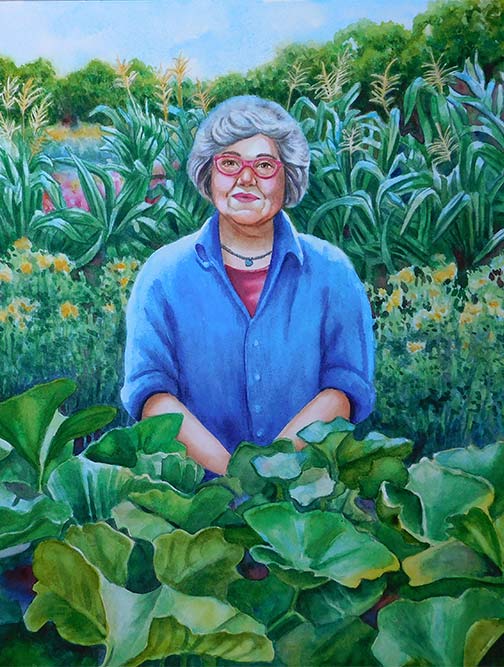
Maria Moreia
The American Dream is an adage held onto by generations of newcomers. Maria Moreia, an immigrant herself from the Azores Islands of Portugal, helped to facilitate that dream for many immigrants in Central Massachusetts through the nonprofit World Farmers based at Flats Mentor Farm in Lancaster. It all started with a dairy farmer and some cheese.
Moreia found herself in the dairy farming industry through marriage. A legacy farmer, Moreia began producing Portuguese cheese to supplement her family’s income. In the early 1980s, the region where she lived saw an influx of Hmong immigrants, refugees from the Vietnam War crisis. Looking for a place to grow traditional Southeast Asian produce, a Hmong woman approached Moreia about starting a garden on a patch of land between two barns. That simple request soon grew, as 190 Hmong farmers joined in to use the land of Flats Mentor Farm. Today, over 300 farmers from all over the world, the majority of them being women, use this land.
The USDA honored Flats Mentor Farm in 1999 when they identified it as a national model for beginning farmer programs. In 2010, Moreia founded World Farmers at Flats Mentor Farm. Building upon Moreia’s previous work, the nonprofit aims to “to support small farmers in sustainable agricultural production and successful marketing practices to connect culturally relevant produce to viable markets.” Through mentoring, training, and hands-on assistance, each farmer learns how to operate individual farming enterprises. In fact, 30% of the farmers who have worked on the land of Flats Mentor Farm have gone on to farm their own land. Now covering 70 acres, Flats Mentor Farm produces ethnic specialty crops that are supplied to over 40 farmers’ markets all over New England as well as many other small scale direct-to-consumer outlets plus wholesalers.
About the Artist, Rachel Armington
Rachel Armington works primarily in watercolor and acrylic. Although originally painting more transparently, Rachel has been experimenting with more opaque, heavily granulating pigments that add texture and body to the paper’s surface. She is also a published educational and children’s writer. Her original artwork, commissions, and prints are in collections around the world.
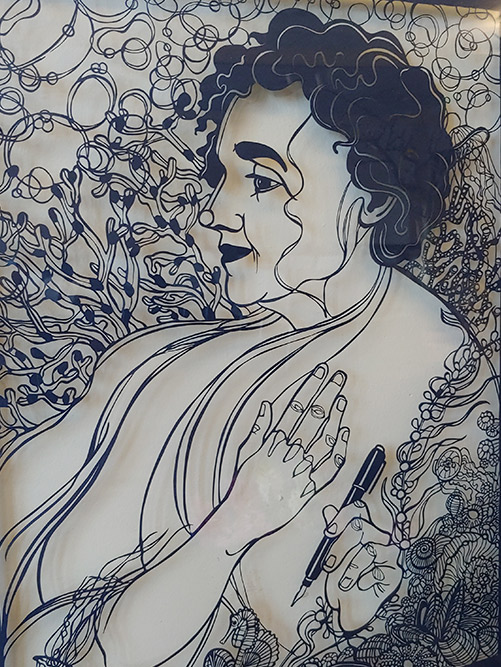
Rachel Carson (1907-1964)
“Hey farmer, farmer put away that DDT now / Give me spots on my apples, but leave me the birds and the bees, please,” was written by Joni Mitchell in 1970, eight years after Rachel Carson’s groundbreaking book Silent Spring exposed the hazards of the pesticide. Her most famous work, Silent Spring was really the capstone to Carson’s long career in biology that included tremendous advocacy for environmental protection.
Originally an English major, Carson discovered her love of biology and the natural world while studying at the Pennsylvania College for Women, now Chatham University. She would go on to earn her Ph.D. in Zoology from Johns Hopkins University. Her conservation work began in 1936 when she became the second woman ever hired by the U.S. Bureau of Fisheries, now the U.S. Fish and Wildlife Service. In her role she wrote pamphlets about natural resources and their conservation and edited scientific articles. In the 1950s, she published her first two books, The Sea Around Us and The Edge of the Sea. It was around this time she made the decision to become a full-time writer, quitting her job with the federal government.
Carson first tried to sound the alarm on DDT and other harmful pesticides in 1944 when she submitted an article on these hazards to Reader’s Digest. The article was rejected as it was determined that it was “unpleasant.” Carson continued her research on the effects of pesticides, receiving research from Marjorie Spock and Mary T. Richards of Long Island who had contested the aerial spraying of DDT. Carson also heard from a friend in Duxbury, MA who shared that after indiscriminate DDT spraying, there were no longer any birds in her neighborhood.
Published in 1962, Silent Spring led to the release of the President’s Science Advisory Committee report “The Uses of Pesticides.” Following the report, which upheld Carson’s findings, Carson testified in front of multiple Senate committees. Her work is credited for starting an environmental movement that led to the creation of the Environmental Protection Agency in 1970 and the eventual banning of DDT in 1972.
About the Artist, Maria Palkon
Marie Palkon is a Polish illustrator born in the Czech Republic and raised in the U.S. Paper is her medium of choice and she enjoys working on small-scale projects. She finds it to be meditative and rewarding and enjoys that it also provides an intimate storytelling experience. When she is not gently cutting paper under a magnifying glass, she can be found teaching art classes in the South End.
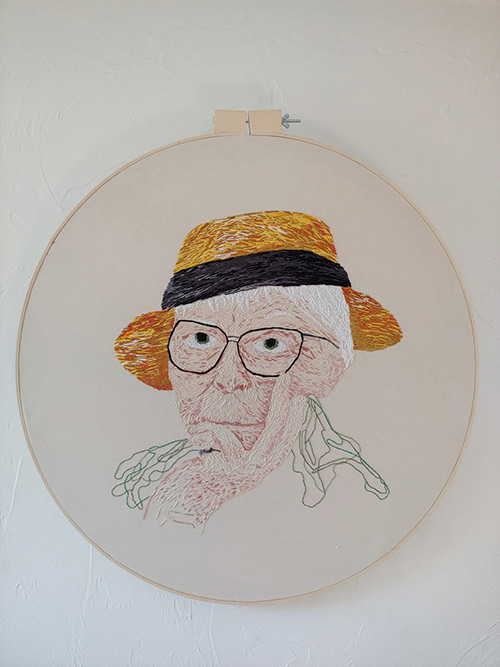
Marjory Stoneman Douglas (1890-1998)
Perhaps the best word to describe Marjory Stoneman Douglas is activist. During her long life, she advocated for women’s suffrage, equal rights, migrant farm workers, libraries, and perhaps most notably, the Everglades. Thanks to Douglas’s efforts, Everglades National Park is the largest protected tropical wilderness in the United States.
Douglas’s work with horticulture and conservation began in the 1920s when she joined the board of the Everglades Tropical National Park Committee. In the 1930s she became involved with a movement to bring a botanical garden to southern Florida and was a sought-after speaker on the topic. She served on the board of the Fairchild Tropical Botanic Garden and worked with David Fairchild whose estate became part of the National Tropical Botanical Garden.
Everglades National Park was established in 1934 and dedicated in 1947, the same year Douglas published The Everglades: River of Grass, a book that has been compared to Rachel Carson’s Silent Spring (1962) for inspiring an environmental movement. In the 1960s, the Everglades were threatened by real estate and agricultural developments, particularly the building of a jetport in the area. In 1969 Douglas founded the Friends of the Everglades to continue to ensure conservation of the region’s unique ecosystems. Douglas claimed, “It is a woman’s business to be interested in the environment. It’s an extended form of housekeeping.” The jetport project was abandoned.
Douglas’s conservation work earned her many accolades including Conservationist of the Year from the Florida Audubon Society and Florida Wildlife Federation and the Presidential Medal of Freedom. The “Guardian of the Glades” legacy lives on through the National Parks Conservation Association’s Marjory Stoneman Douglas Award, established in 1986 and the Marjory Stoneman Douglas Wilderness Area in the Everglades National Park dedicated in 1997. Her cottage in Coconut Grove, FL is now under the care of the Florida Park Service and is designated a National Historic Landmark.
About the Artist, Trish Danforth
Trisha Danforth’s multimedia work explores traditional and non-traditional means of communicating fleeting emotions or memories. Her work is focused on the intersection of material and storytelling. She is currently exploring fiber arts as a way to express the whimsical nature of a historically women-based craft. Her work has been featured in shows such as the Worcester Cultural Coalition ‘Rebirth’ Show, and Amazing Things Art Center Annual Juried Show.
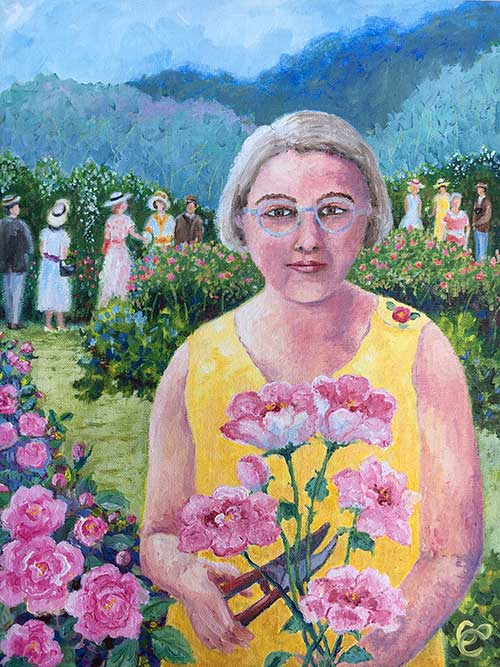
Dr. Cynthia Westcott (1898–1983)
When one thinks of a doctor, perhaps “plant doctor” isn’t the first thing that comes to mind, but that’s what Dr. Cynthia Westcott was. Westcott, a plant pathologist, author, and expert on roses, is credited with starting the first ornamental disease diagnosis business in the United States, thus earning her the nickname “The Plant Doctor.”
Born in North Attleboro, MA, Cynthia Westcott’s love of nature started early on her family’s two farms. Her educational journey took her to Cornell University, where she earned her Ph.D. in 1932. It was at Cornell where Westcott planted her first rose garden, a space she used as a testing ground for sprays. Following graduation, Westcott worked at Rutgers University where the idea of being a “plant doctor” was born. With entomologist Irene Dobroscky, she went into business making house calls to clients’ gardens to diagnose and treat problems in roses and ornamentals. In winters, Westcott wrote, lectured, and traveled. Her first book, appropriately titled The Plant Doctor, was published in 1937.
During WWII, Westcott changed her focus to pest control within victory gardens. Her fame and expertise caught the attention of the U.S. Department of Agriculture, who contacted her in 1943 to study the azalea flower spot, a condition affecting the southern azalea market. Westcott successfully identified the cause of the disease and developed a chemical treatment in a new class of fungicides. She once again turned to lecturing to educate the public on its control.
Westcott was always learning and teaching. While traveling, she would collect specimens to study. She held an annual “Rose Day” where she welcomed the public to her test plots and gardens while serving punch and cookies. Regular attendance was up to 700 visitors. In 1975, Westcott’s work was honored by the American Rose Society’s National Convention with the Jackson and Perkins Company naming a hybrid tea rose “Cynthia” in her honor.
About the Artist, Carrin Culotta
After ten years working as a Biomedical Engineer in the medical imaging field, Carrin retired to raise her three daughters. This allowed time to pursue her lifelong interest in art. She continued honing her painting skills by recording the beauty she encountered near her home. Beginning as a self-taught artist, she has pursued instruction from artists that she admires. She paints in both oil and watercolor.
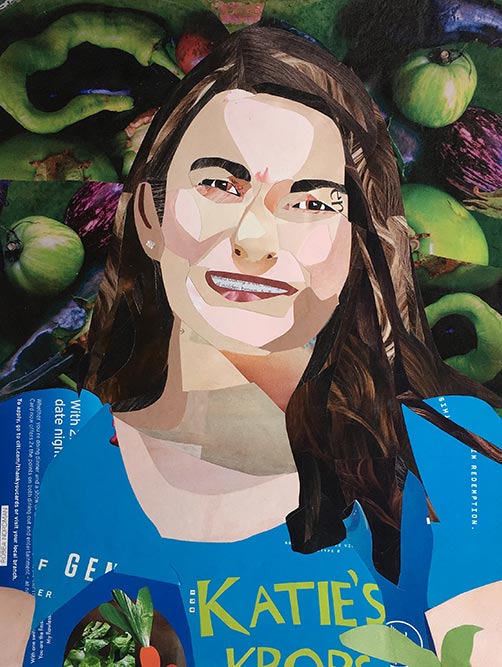
Katie Stagliano
It all started in third grade. Katie Stagliano grew a 40-pound cabbage that ended up feeding 275 guests at a local soup kitchen. Stagliano was empowered to do more and started the nonprofit, Katie’s Krops. The organization has grown to include over 300 gardens in 30 states as well as two African nations.
Based out of Summerville, SC, the mission of Katie’s Krops is to teach youth how to start and maintain environmentally friendly vegetable gardens that provide a sustainable solution to hunger. Katie’s Krops offers free dinners, provided by high school students, to those in need. Through sponsorships, they also hold a summer camp called Katie’s Krops Growers where creative growing techniques are taught, and campers participate in a service project.
During the shutdowns of the COVID-19 pandemic, Stagliano and Katie’s Krops had to pivot to be able to offer people desperately needed meals in a safe environment. A take-out service was born, and anyone was welcome to drive up and get a meal for free. Meanwhile, staff members delivered over 200 meals per monthly dinner, with over 600 meals served overall.
Stagliano has been honored with numerous awards, including the Clinton Global Citizen Award for Leadership in Civil Society in 2012. She was the youngest ever recipient of this award. But perhaps the biggest honor is that through Katie’s Krops over 30,000 meals and 600,000 pounds of food have been donated.
About the Artist, Robea Nordman
After studying photography at Endicott College, Robea’s love of creating moved to digital photographic collages, painting, illustrating, and mixed-media work. She is an artist and a teacher; one inspires the other and both allow her to experiment with a variety of media. She loves creating pieces with many layers and several stages. Her process is evolving, and she hopes it always will.
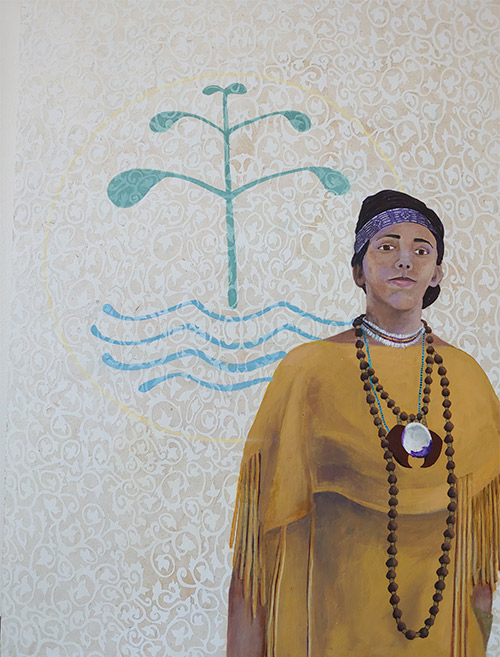
Zara CiscoeBrough (1919–1988)
In the town of Grafton there sits a three and a half-acre plot of land known as the Hassanamisco Reservation, the only Native American reservation in Massachusetts that has never left indigenous occupation. This is in large part due to Zara CiscoeBrough, who worked throughout the twentieth century to preserve Nipmuc culture, history, and land.
Zara CiscoeBrough, also known as Princess White Flower, grew up in the Cisco Homestead on Brigham Hill Road in Grafton, MA. Following a career in textiles in Washington, D.C. and the United States Air Force, where she was recognized with the Award of Superior Performance, CiscoeBrough returned to Massachusetts and her childhood home. Always fascinated by her heritage thanks to oral histories passed down by her grandfather and the women in her family, CiscoeBrough became a champion for the Hassanamisco Nipmuc.
Long before CiscoeBrough returned to the region, the Cisco Homestead where she was raised served as a representation of Hassanamisco Nipmuc history and informal visits to learn more about the tribe’s heritage were always welcome. Logs from CiscoeBrough’s mother’s time as caretaker show hundreds of annual visitors. Starting in the 1920s, the homestead and the land started to be used regularly for tribal activities. CiscoeBrough formally opened the homestead as the Hassanamisco Indian Museum in 1962, nicknaming it the “Memorial to the Eastern American Indian.”
CiscoeBrough knew from a young age that she would be the steward of this important cultural landscape. She cared deeply about her community and blended her leadership roles in both the Nipmuc Tribe and local politics. From 1962 to 1987, she served as the sachem (chief) of the Nipmuc Nation and on various town commissions such as the Planning Board, Cemetery Commission, and the Grafton Forest Association. Through CiscoeBrough’s efforts, in 1974 the Massachusetts Commission on Indian Affairs was established, and she was nominated to the position of Commissioner of Indian Affairs which she held from 1976 to1984. Under her leadership, the charter of the Hassanamisco Foundation was amended to state that Nipmuc reservation lands would never leave Nipmuc hands. It was also thanks to CiscoeBrough’s activism that the Aquinnah, Mashpee, and Nipmuc tribes were given state recognition in 1976.
Today, the Hassanamisco Indian Museum and Hassanamisco Reservation stand as a testament to Nipmuc heritage and CiscoeBrough’s work to preserve it. Annual powwows and tribal activities are still held on the reservation and hopefully will continue for generations to come.
About the Artist, Jamie Andrade
Jamie Andrade received her BFA from Massachusetts College of Art and Design and her Masters from Boston University. Her work is a mix of Constructivism and Creolisation with flat graphic shapes that echo West African patterns. She teaches high schoolers in Chinatown, Boston where her classes explore art and cultural expression.

